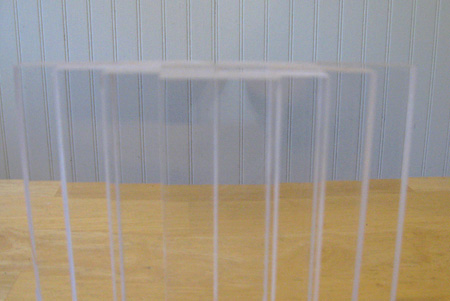My apologies for not being more visible in this discussion, but it’s been more fun just kibitzing.
But I’ve noticed that Morandi has become front-of-mind of late; to the extent that his characteristics are influencing what gets my attention. Today I was cutting pieces of plexiglass to make into chains. I was lining them up when – behold – there was a little Morandi assembly.
Frankly, there’s little resemblance. No painterliness is in evidence, but things are arranged after a fashion and one can see an intersection of table and wall. For some reason this was enough to trigger the association.
The plexiglass blocks go into the likes of this prototype seen here in a basket of apples. I’m tempted to make up some shapes similar to those used by Morandi – this as an adjunct to Steve’s experiments with the bottles.
I was going to ask rhetorically if you find your focus and sensitivities influenced by these discussions on A&P, but I know the answer already. For me, the scanner of limited attention, it’s the concentration. Any comments?



Personally, I’m about Morandi’d out for now, but I enjoy the short bursts of saturation exposure. I take it that’s what you mean by concentration. For the record, there are some still lifes with fruit in his early work, as well as some quite Cezannish paesaggi.
Interesting about your Plexi chains: depending on the angles of light sources (and degree of polish), the links can be nearly transparent or effectively opaque.
The colors, beige and blue, of the first image are very Morandi 1964
Steve:
I will now read you your Morandi rites. The party is just beginning as there is a big review of the Morandi exhibit in Artnews magazine.
My eyes tend to bask in, rather than register, whatever is presented to them. These discussions force me to actually pick up and turn over things in my mind, and I then better remember their weight and solidity. I might say that one of the benefits of a scientific background is that one learns to hold a thought.
And again, we have often mentioned the ways that photography shapes the thing perceived. In this case transparency and opacity are in constant flux.
Birgit:
That may have been one of the reasons that I was reminded.
Jay,
I had never realized that one could vary one’s art by photographing plexiglass that gets moved around. Opacity and transparency indeed! The use of the plexi to make the chain adds another dimension to your art. And then photographing it places it into yet a different modality.
I had to pause over the word “modality” — I’m not sure exactly if that’s what I mean. If Steve’s art is in the photography and mine in the oil, yours seems to inhabit two places or maybe three spaces — the object as it is arranged; the object as it can be rearranged; and the object as it looks when photographed and rephotographed in differing positions. It’s a bit like Andy Goldsworthy’s ice art or sand sculpture that has been overcome by the elements and now exists only in photographs. Only yours is still extant.
I like the play of transparency/opacity that Steve noted — I wonder how many good variations you could get from moving and photographing. You’d have to hold the background stable, though, or we’d be into too much for my brain to manage.
Guys:
Maybe I should have been a glass maker, because I surely love the transparency. There is a glass gallery in town that intrigues me always.
The plexiglass seems a proper direction. It’s tough to get right, but I’m making some progress. The third of June’s “modalities” involves a camera, for which one’s roving eye can substitute. And, yes the transparency does bring the background – or at least the surrounds – into the mix.